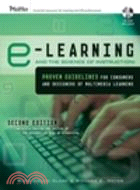| FindBook |
有 1 項符合
E-LEARNING AND THE SCIENCE OF INSTRUCTION 2/E (W/CD)的圖書 |
| 圖書館借閱 |
| 國家圖書館 | 全國圖書書目資訊網 | 國立公共資訊圖書館 | 電子書服務平台 | MetaCat 跨館整合查詢 |
| 臺北市立圖書館 | 新北市立圖書館 | 基隆市公共圖書館 | 桃園市立圖書館 | 新竹縣公共圖書館 |
| 苗栗縣立圖書館 | 臺中市立圖書館 | 彰化縣公共圖書館 | 南投縣文化局 | 雲林縣公共圖書館 |
| 嘉義縣圖書館 | 臺南市立圖書館 | 高雄市立圖書館 | 屏東縣公共圖書館 | 宜蘭縣公共圖書館 |
| 花蓮縣文化局 | 臺東縣文化處 |
|
|
- 圖書簡介
In this thoroughly revised edition of the bestselling e-Learning and the Science of Instruction authors Ruth Colvin Clark and Richard E. Mayer— internationally-recognized experts in the field of e-learning—offer essential information and guidelines for selecting, designing, and developing asynchronous and synchronous e-learning courses that build knowledge and skills for workers learning in corporate, government, and academic settings. In addition to updating research in all chapters, two new chapters and a CD with multimedia examples are included.
- 作者簡介
Ruth Colvin Clark has worked for more than twenty-five years with instructional professionals assigned to design, develop, and select effective training for classroom or computer delivery. She is widely published in the areas of training, development, and performance improvement.
Richard E. Mayer is professor of psychology at the University of California, Santa Barbara. He is an internationally-recognized expert in the application of learning psychology to design of instruction in multimedia learning environments and the author of Multimedia Learning and is the editor of the Cambridge Handbook of Multimedia Learning. - 名人/編輯推薦
“Their first edition was a landmark work. This new edition is even better. Too many guidelines for instructional design are based on opinion or an attempt to be consistent with some philosophical position. It is most refreshing when one of the world's most respected learning researchers teams with the premier translator of scientific findings to produce a set of e-learning guidelines based on empirical research findings. Both novice and experienced instructional designers will observe more effective and efficient learning from their instructional products if they implement the guidelines in this book.”--M. David Merrill, visiting professor, Florida State University
“As a scholar-practitioner, e-Learning and the Science of Instruction has been an invaluable resource. Clark and Mayer have a knack for placing theory into applicable and practical examples of instructionally sound e-learning. In the last 4 years, I have used this book as a reference for several e-learning courses and as a manager of several instructional designers. Quite frankly, our field needs more evidenced-based examples of instructionally sound e-learning and less of the ‘wow’ factor!”--Gina Ann Richter, president, GO-Learning Inc.
“This book is required reading in my graduate-level Instructional Media Design course. As an instructor, I appreciate the sound empirical basis for the book’s e-learning guidelines. The students, on the other hand, are grateful for the clear, concise language used to describe the guidelines, which makes their application straightforward.”--Robert K. Atkinson, psychology in education, Arizona State University - 目次
Acknowledgments.
Preface.
Introduction.
1. e-Learning: Promise and Pitfalls.
The e-Learning Bandwagon.
What Is e-Learning?.
Self-Study vs. Virtual Classroom e-Learning.
e-Learning Development Process.
Two Types of e-Learning Goals: Inform and Perform.
Is e-Learning Better? Media Comparison Research.
What Makes e-Learning Unique?
e-Learning: The Pitfalls.
What Is Good e-Courseware?
Learning in e-Learning.
2. How Do People Learn from e-Courses.
How Do People Learn?
How Do e-Lessons Affect Human Learning?
What Is Good Research?
How Can You Identify Relevant Research?
How Do You Interpret Research Statistics?
What We Don't Know About Learning.
3. Applying the Multimedia Principle: Use Words and Graphics, Rather Than Words Alone.
Do Visuals Make a Difference?
Multimedia Principle: Include Both Words and Graphics.
Some Ways to Use Graphics to Promote Learning.
Psychological Reasons for the Multimedia Principle.
Evidence for Using Words and Pictures.
The Multimedia Principle Works Best for Novices.
Should You Change Static Illustrations into Animations?
What We Don't Know About Visuals.
4. Applying the Contiguity Principle: Align Words to Corresponding Graphics.
Contiguity Principle 1: Place Printed Words Near Corresponding Graphics.
Contiguity Principle 2: Synchronize Spoken Words with Corresponding Graphics.
Psychological Reasons for the Contiguity Principle.
Evidence for Presenting Printed Words Near Corresponding Graphics.
Evidence for Presenting Spoken Words at the Same Time as Corresponding Graphics.
What We Don't Know About Contingency.
5. Applying the Modality Principle: Present Words as Audio Narration, Rather Than On-Screen Text.
Modality Principle: Present Words as Speech Rather Than On-Screen Text.
Limitations to the Modality Principle.
Psychological Reasons for the Modality Principle.
Evidence for Using Spoken Rather Than Printed Text.
When the Modality Principle Applies.
What We Don't Know About Modality.
6. Applying the Redundancy Principle: Explain Visuals with Words in Audio or Text: Not Both.
Redundancy Principle 1: Do Not Add On-Screen Text to Narrated Graphics.
Psychological Reasons for the Redundancy Principle.
Evidence for Omitting Redundant On-Screen Text.
Redundancy Principle 2: Consider Adding On-Screen Text to Narration in Special Situations.
Psychological Reasons for Exceptions to Redundancy Principle.
Evidence for Including Redundant On-Screen Text.
What We Don't Know About Redundancy.
7. Applying the Coherence Principle: Adding Interesting Material Can Hurt Learning.
Coherence Principle 1: Avoid e-Lessons with Extraneous Audio.
Psychological Reasons to Avoid Extraneous Audio in e-Learning.
Evidence for Omitting Extraneous Audio.
Coherence Principle 2: Avoid e-Lessons with Extraneous Graphics.
Psychological Reasons to Avoid Extraneous Graphics in e-Learning.
Evidence for Omitting Extraneous Graphics.
Coherence Principle 3: Avoid e-Lessons with Extraneous Words.
Psychological Reasons to Avoid Extraneous Words in e-Learning.
Evidence for Omitting Extraneous Words Added for Interest.
Evidence for Omitting Extraneous Words Added to Expand on Key Ideas.
Evidence for Omitting Extraneous Words Added for Technical Depth.
What We Don't Know About Coherence.
8. Applying the Personalization Principle: Use Conversational Style and Virtual Coaches.
Personalization Principle 1: Use Conversational Style Rather Than Formal Style.
Psychological Reasons for the Personalization Principle.
Evidence for Using Conversational Style.
Promote Personalization Through Voice Quality.
Promote Personalization Through Polite Speech.
Personalization Principle 2: Use Effective On-Screen Coaches to Promote Learning.
Personalization Principle 3: Make the Author Visible to Promote Learning.
Psychological Reasons for Using a Visible Author.
Evidence for the Visible Author.
What We Don't Know About Personalization.
9. Applying the Segmenting and Pretraining Principles: Managing Complexity by Breaking a Lesson into Parts.
Segmenting Principle: Break a Continuous Lesson into Bite-Size Segments.
Psychological Reasons for the Segmenting Principle.
Evidence for Breaking a Continuous Lesson into Bite-Size Chunks.
Pretraining Principle: Ensure that Learners Know the Names and Characteristics of Key Concepts.
Psychological Reasons for the Pretraining Principle.
Evidence for Providing Pretraining in Key Concepts.
What We Don't Know About Segmenting and Pretraining.
10. Leveraging Examples in e-Learning.
Worked Examples: Fuel for Learning.
How Worked Examples Work.
How to Leverage Worked Examples: Overview.
Worked Example Principle 1: Transition from Worked Examples to Problems via Fading.
Worked Example Principle 2: Promote Self-Explanations of Worked-Out Steps.
Worked Examples Principle 3: Supplement Worked Examples with Explanations.
Worked Examples Principle 4: Apply the Multimedia Principles to Examples.
Worked Examples Principle 5: Support Learning Transfer.
Design Guidelines for Near-Transfer Learning.
Design Guidelines for Far-Transfer Learning.
What We Don't Know About Worked Examples.
11. Does Practice Make Perfect?
What Is Practice in e-Learning?
The Paradox of Practice.
How to Leverage Practice: Overview.
Practice Principle 1: Mirror the Job.
Practice Principle 2: Provide Explanatory Feedback.
Practice Principle 3: Adapt Amount and Placement of Practice to Job Performance Requirements.
Practice Principle 4: Apply the Multimedia Principles.
Practice Principle 5: Transition from Examples to Practice Gradually.
What We Don't Know About Practice.
12. Learning Together Virtually.
What Is Computer-Supported Collaborative Learning (CSCL).
Factors That Make a Difference: Overview.
Is Problem-Solving Learning Better with CSCL or Solo?.
Virtual vs. Face-to-Face Group Decisions.
Software Representations to Support Collaborative Work.
Group Roles and Assignments in CSCL.
Team-Building Skills and CSCL Outcomes.
Collaborative Structures and CSCL.
Collaborative Group Structures.
CSCL: The Bottom line.
13. Who's in Control? Guidelines for e-Learning Navigation.
Learner Control Versus Program Control.
Do Learners Make Good Instructional Decisions?.
Four Principles for Learner Control: Overview.
Learner Control Principle 1: Give Experienced Learners Control.
Learner Control Principle 2: Make Important Instructional Events the Default.
Learner Control Principle 4: Give Pacing Control.
Navigational Guidelines for Learner Control.
What We Don't Know About Learner Control.
14. e-Learning to Build Thinking Skills.
What Are Thinking Skills?.
Can Creativity Be Trained?.
Building Critical-Thinking Skills in the Workforce: Overview.
Thinking Skills Principle 1: Use Job-Specific Cases.
Psychological Reasons for Job-Specific Training.
Evidence for Job-Specific Problem-Solving Training.
Thinking Skills Principle 2: Make Thinking Processes Explicit.
Thinking Skills Principle 3: Define Job-specific Problem-Solving Processes.
Teaching Thinking Skills: The Bottom Line.
What We Don't Know About Teaching Thinking Skills.
15. Simulations and Games in e-Learning.
The Case for Simulations and Games.
Do Simulations and Games Teach?
Balancing Motivation and Learning.
Games and Simulations Principle 1: Match Game Types to Learning Goals.
Games and Simulations Principle 2: Make Learning Essential to Progress.
Features that Lead to Learning.
Games and Simulations Principle 3: Build in Guidance.
Games and Simulations Principle 4: Promote Reflection on Correct Responses.
Games and Simulations Principle 5: Manage Complexity.
What We Don't Know About Simulations and Games.
16. Applying the Guidelines.
Applying Our Guidelines to Evaluate e-Courseware.
e-Lesson Reviews.
Asynchronous Samples One and Two: Design of Databases.
Synchronous Sample Three: Constructing Formulas in Excel.
Asynchronous Sample Four: Simulation Course for Commercial Bank Loan Analysis.
The Next Generation of e-Learning.
In Conclusion.
References.
Glossary.
Index.
About the Authors.
How to Use the CD-ROM.
|












